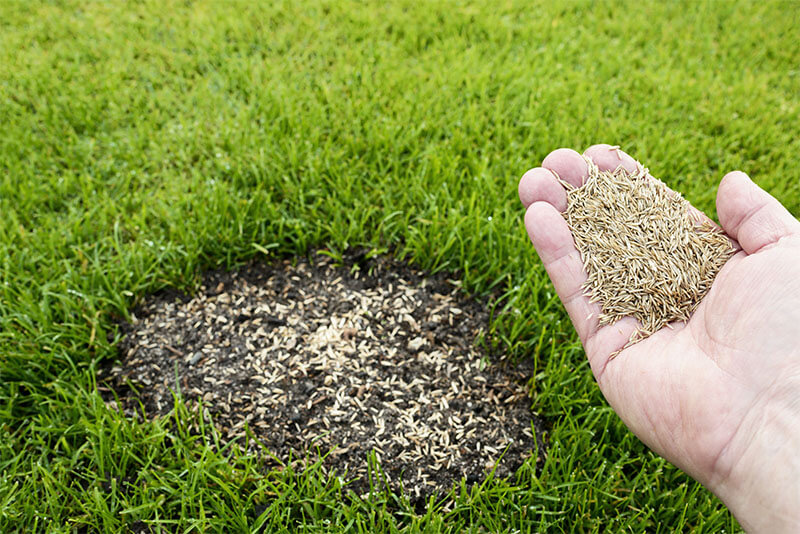Be ready for next spring!
Everybody enjoys a great looking lawn. It improves the way your home looks and adds to the value, as well as reducing soil erosion. It also acts as a filtration system of sorts for groundwater and improves air quality by absorbing dust and other particles, at the same time producing oxygen. Whether you are starting a new lawn from scratch or adding to an existing lawn, planting grass seed will help give you a beautiful, green lawn.
If you are starting a new lawn, using seed is a great way to get the lush, beautiful environment that you are looking for. The first thing you will need to do is select what type of grass you wish to grow. In order to pick the right type of grass for your purposes, you will need to consider a variety of factors:
- Take into account your climate. Various type of grass grow better or worse in various climates. Not all grass seed is created equal and you need to consider the best type for the part of the country that you live in.
- The amount of sun and shade exposure in your yard is important. Again, different grass seed will grow well with more direct sunlight, and some will grow better in a more shaded environment.
- Think about the amount of maintenance that you want to do. Some varieties will grow a lush and thick lawn, but they will require more care and more maintenance than others. Make sure you are planting a type that you have the time to maintain according to your busy schedule.
- Take into account the amount of traffic your lawn will receive. Planting a seed that will absorb the level of impact on your lawn is important.
There are two main categories of turf grass to consider: warm climate and cool climate. Much as their titles imply, warm climate grows best in the south in hot weather. Warm season grass will grow dormant in cool temperatures and turn brown. This type should be planted in the late spring. Cool season grass originates in the north and typically grows the most in the spring and fall seasons. Cool season grass will often turn brown during high temperatures in the summer. The best time to plant this type of grass is late summer or early fall. The most common warm season grass includes Bahia, St. Augustine, Bermuda, and Zoysia. The most common types of cool season grass are Ryegrass, Kentucky Bluegrass, and Fescue.
When you go to purchase grass seed, you will find a lot of the information you need on the label. For the most part, you will be looking at either straight seed or blends. Straight seed is useful in situations where you are trying to achieve a certain look or effect. Blends are best for a uniform lawn and are also better at resisting disease. For blends, the types of grass will vary from blend to blend, as will the percentage of each.
It is usually best to avoid seed that does not state the variety of grass, as this can indicate poor seed quality. The germination percentage will also be listed on the label and this indicates how much of the seed will grow under ideal growing conditions. Keep in mind that you will not always be seeding under ideal growing conditions, so you want a germination rate of 75% or above.
Before planting the seed you have selected, you will need to make sure the soil is properly prepared. This may include tilling it or using a hoe, and removing any rocks, weeds, or other debris. You can then mix in some organic material to allow the soil to retain water and rake until it is smooth. Next comes the fertilizer that should be spread evenly to help the new grass grow. After that step, sow the grass evenly and rake the seed into the top eighth inch of top soil.
Here are some other tips as you are going through these steps:
- For larger areas you will want to use a spreader of some kind. For smaller areas, you can sow the seed by hand.
- You can use either straw or some type of garden fabric to mulch the seeded area.
- Water your newly seeded area daily up until the time that germination occurs. Then you will want to back off a bit and water less often, but more heavily.
- When the new grass reaches a height of three inches, you should remove the mulch and mow.
- It best to protect your new lawn from traffic while it is coming to germination by roping it off so that animals and foot traffic do not impede the process.
Irrigation systems are great for cultivating your newly sown lawn. Many people install an underground sprinkler system at the same time as they plant. This enables you to maintain the new lawn with less effort. Above ground sprinklers are great for small lawns or smaller areas that you need to devote more effort to. Many people also utilize rain barrels, as it is a great way to collect water to use without driving up your water bill. It is also good for the environment and kind of fun to use something that nature is giving you for free!
Weed control products are another aspect that may be a necessity for your new lawn, depending upon the environment where you live. These products will decrease the amount of vegetation that ends to drain your soil of the water and nutrients that your lawn needs. Various herbicides that you will find can be liquid or granular and will kill everything from dandelions to crabgrass.
Recent developments have seen more organic weed control products hit the market that use either oils or acids to kill weeds. Many people use these as they do not release any harmful chemicals into the soil and are much better for the environment.
For more information or to get your questions answered, stop by one of our Farm & Ranch Supply stores today!


